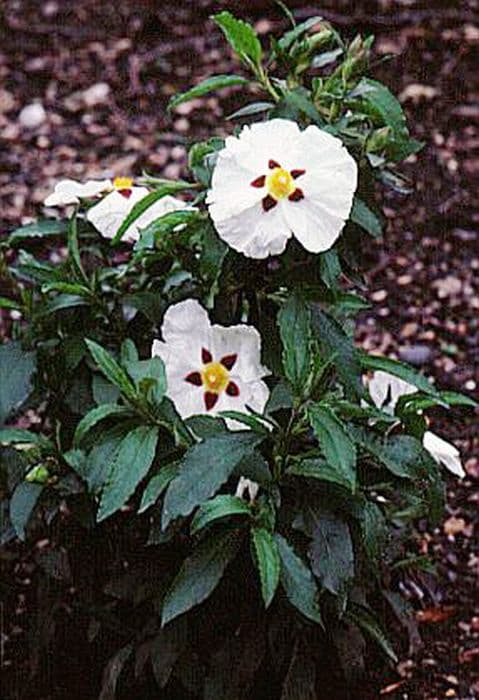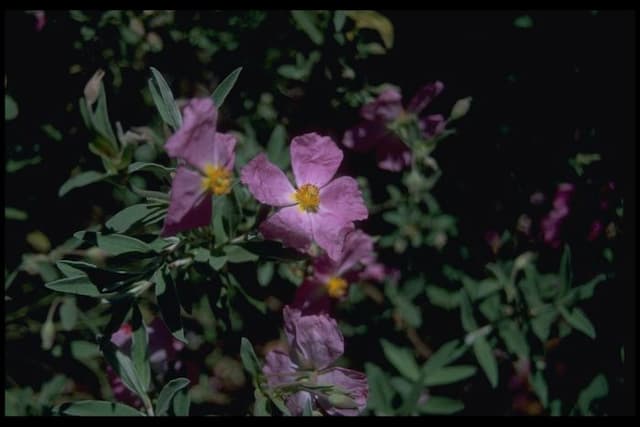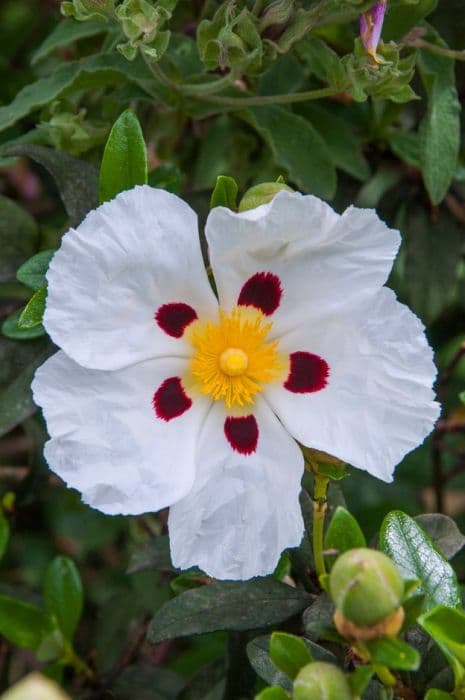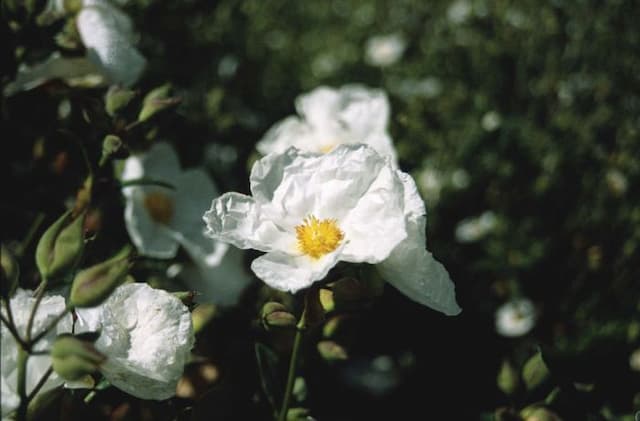Rock rose Helianthemum 'Jubilee' (d)

ABOUT
The Helianthemum 'Jubilee' is a striking flowering plant characterized by its vibrant display of flowers and foliage. Starting with the blooms, they are often a bright and cheerful shade, creating a lively splash of color that's eye-catching in any garden setting. Each flower is composed of delicate petals that radiate from the center, where a cluster of contrasting stamens can usually be found. The petals can have a satiny sheen, giving the blossoms a lively, sunlit appearance as if capturing the essence of a sunny day. When not blooming, the plant is still quite beautiful due to its evergreen leaves. The foliage tends to be dense, creating a lush tapestry that spreads across the area where it's planted. The leaves themselves are typically small to medium in size and may have a slightly textured or fuzzy surface, which adds to the tactile appeal of the plant. They are often a deep green color, providing a rich backdrop for the flowers and making the plant attractive throughout all seasons. The overall growth habit of the Helianthemum 'Jubilee' is neat and mounded, creating a tidy appearance in the landscape. This growth form allows it to be used effectively as ground cover or in rock gardens, where its low profile and spreading nature help to cover the ground elegantly. Additionally, when in bloom, the compact clusters of flowers can blanket the plant, creating a dazzling effect that can brighten up any garden corner. Also worth mentioning are the stems of the Helianthemum 'Jubilee,' which support both the leaves and flowers. They tend to blend seamlessly with the foliage, providing a stable structure without detracting from the plant's ornamental appeal. The combination of vibrant blooms, evergreen foliage, and a gracefully spreading habit make the Helianthemum 'Jubilee' a desirable choice for gardeners looking to add a touch of perennial beauty to their landscape.
About this plant
 Names
NamesFamily
Cistaceae
Synonyms
Rock Rose, Sunrose
Common names
Helianthemum 'Jubilee'
 Toxicity
ToxicityTo humans
The common name for Helianthemum 'Jubilee' is Rock Rose. Rock Rose is not known to be toxic to humans. Therefore, no symptoms of poisoning or consequences of ingesting this plant are typically expected.
To pets
The common name for Helianthemum 'Jubilee' is Rock Rose. Rock Rose is not commonly known to be toxic to pets. This means that ingesting this plant should not cause poisoning symptoms or adverse consequences in animals such as cats and dogs under normal circumstances.
 Characteristics
CharacteristicsLife cycle
Perennials
Foliage type
Evergreen
Color of leaves
Green
Flower color
Yellow
Height
1 foot [30 cm]
Spread
2 feet [60 cm]
Plant type
Shrub
Hardiness zones
5
Native area
Mediterranean
Benefits
 General Benefits
General Benefits- Attracts pollinators: The Helianthemum 'Jubilee', commonly known as Rock Rose, produces flowers that can attract bees, butterflies, and other beneficial insects to the garden.
- Drought resistant: Once established, Rock Rose is highly resistant to drought, making it suitable for xeriscaping or low-water landscapes.
- Low maintenance: It requires minimal care once established, with no need for frequent watering or fertilization, making it an ideal choice for gardeners seeking low-maintenance plants.
- Ground cover: Its dense growth habit helps to cover bare ground, suppress weeds, and stabilize soil, which can help in erosion control.
- Decorative: Rock Rose offers decorative value with its vibrant flowers and evergreen leaves, making it a popular choice for ornamental gardening.
- Suitable for rock gardens: Its adaptability to rocky and sandy soils makes it perfect for rock gardens and similar challenging garden spaces.
- Full sun adaptation: This plant thrives in full sun conditions, which makes it suitable for sunny areas of the garden where other plants might struggle.
- Wildlife habitat: Rock Rose can provide shelter and nesting opportunities for small wildlife, contributing to biodiversity in the garden.
 Medical Properties
Medical PropertiesThis plant is not used for medical purposes.
 Air-purifying Qualities
Air-purifying QualitiesThis plant is not specifically known for air purifying qualities.
 Other Uses
Other Uses- Rock garden accent: Helianthemum 'Jubilee' can be used to add texture and color contrasts in rock gardens, highlighting its evergreen foliage and vibrant blooms.
- Container planting: This plant can be grown in containers on patios or balconies, where its low-growing habit makes it an attractive addition to mixed plantings.
- Ground cover: Its spreading nature makes it useful for covering large areas in garden landscapes, providing both ornamental value and weed suppression.
- Bonsai: Some enthusiasts may use Helianthemum 'Jubilee' in bonsai art, given its small size and potential for pruning into miniature tree forms.
- Erosion control: The plant's dense growth habit makes it helpful for stabilizing loose soils on slopes and preventing soil erosion.
- Edging paths: The low and mounding form of Helianthemum 'Jubilee' can be used to edge garden paths, creating a defined border between walkways and garden beds.
- Culinary garnish: Although not commonly used for culinary purposes, its colorful flowers could potentially be used as a decorative garnish for some dishes.
- Photography: The bright and contrasting flowers of Helianthemum 'Jubilee' make it a favorite subject for garden photographers, especially in macro photography.
- Butterfly gardening: The plant can be included in butterfly gardens to attract pollinators, as its flowers are a source of nectar for various species of butterflies and bees.
- Garden themes: Helianthemum 'Jubilee' can be used in themed gardens, such as Mediterranean or drought-tolerant landscapes, due to its tolerance of dry conditions.
Interesting Facts
 Feng Shui
Feng ShuiThe Rock Rose is not used in Feng Shui practice.
 Zodiac Sign Compitability
Zodiac Sign CompitabilityThe Rock Rose is not used in astrology practice.
 Plant Symbolism
Plant Symbolism- Endurance and Survival: Helianthemum, commonly known as Rock Rose, symbolizes endurance and survival due to its ability to thrive on rocky, arid soil where other plants may struggle.
- Beauty and Resilience: Despite its tough nature, Rock Rose blooms with beautiful flowers, often seen as a representation of beauty and resilience amidst harsh conditions.
 Water
WaterWater the rock rose, upon checking the top inch of the soil, ensuring that it has begun to dry out before watering again. Typically, this might mean watering approximately once a week, but this can vary depending on the environment and season. Use a watering can to gently soak the soil around the plant, applying roughly one to two gallons of water, depending on the size of the plant and the dryness of the soil. Avoid waterlogging the plant as rock roses prefer well-draining soil. During the winter months, reduce the frequency of watering since the plant will go dormant and require less moisture.
 Light
LightRock rose thrives in full sun, meaning it prefers to receive at least six hours of direct sunlight each day. The ideal spot for this plant would be a south-facing garden bed or a sunny slope that is well-drained. Partial shade is tolerated, especially in hot climates, but too much shade can lead to sparse flowering and a leggy growth habit.
 Temperature
TemperatureRock rose plants are hardy in a range of temperatures, but they perform best when the temperature is between 60 and 80 degrees Fahrenheit. They are capable of withstanding short periods of frost, but prolonged exposure to temperatures below 20 degrees Fahrenheit may harm the plant. Ideal growing conditions would also protect the plant from extreme winter cold and intense summer heat.
 Pruning
PruningPrune rock rose to maintain its shape and encourage bushier growth. The best time for pruning is after the plant has finished blooming, usually in late spring or early summer. Cut back the spent flowers and about a third of the plant’s overall height to stimulate new growth and prepare for the next flowering season. Pruning regularly, at least once a year, also helps to rejuvenate the plant.
 Cleaning
CleaningNot needed
 Soil
SoilRock Rose 'Jubilee' prefers well-draining soil with some sand or grit, in a mix designed for cacti or succulents. It requires a soil pH between 6.0 and 7.5.
 Repotting
RepottingRock Rose 'Jubilee' does not need frequent repotting; it is typically done every 2-3 years unless the plant outgrows its container.
 Humidity & Misting
Humidity & MistingRock Rose 'Jubilee' is tolerant of dry conditions and does not require high humidity, making it suitable for typical indoor environments.
 Suitable locations
Suitable locationsIndoor
Provide bright light and well-draining soil for Rock Rose 'Jubilee'.
Outdoor
Plant in sunny spot with well-draining soil for Rock Rose 'Jubilee'.
Hardiness zone
Rock Rose 'Jubilee' fits in the 5-9 USDA hardiness zones.
 Life cycle
Life cycleThe life cycle of the Helianthemum 'Jubilee', commonly known as Rock Rose, starts with seed germination, commonly in early spring. After germination, the seedling begins to establish its root system and develop foliage, thriving in well-drained, sandy soil with ample sunlight. As it matures, the plant forms a low, bushy mound of small green leaves, and by late spring to early summer, it starts to produce a profusion of brightly colored, cup-shaped flowers, usually lasting several weeks. Once pollinated, often by bees, the flowers will produce small brown capsules filled with seeds by late summer. During fall, the plant prepares for dormancy by slowing its growth as temperatures drop; in mild climates, it may remain evergreen, while in colder regions it can die back to the ground. The plant's life cycle is perennial, thus after winter dormancy, it will regrow from the base and the cycle begins anew.
 Propogation
PropogationPropogation time
Spring-Early Summer
Helianthemum 'Jubilee', commonly known as Rock Rose, is typically propagated through semi-hardwood cuttings. The ideal time for taking cuttings is in summer when the plant has finished its main flush of flowering, usually late July to August. To propagate Rock Rose, a gardener should carefully select healthy, non-flowering stems and cut a length of about 4 to 6 inches (10 to 15 cm), just below a leaf node. The lower leaves should be removed, and the cutting can be dipped in a rooting hormone to encourage root development, though this is not strictly necessary. The cutting is then placed in a pot filled with a mixture of peat and perlite or a well-draining potting soil, ensuring that at least one node is buried where roots can form. The cutting should be kept moist and placed in a warm area with indirect sunlight until roots have developed, which usually takes several weeks. Once rooted, the new Rock Rose plants can be gradually acclimatized to outdoor conditions before planting out into their permanent positions.









